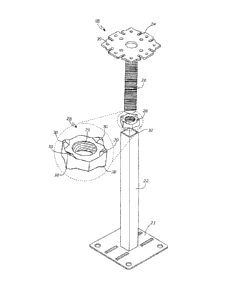Une partie des informations de ce site Web a été fournie par des sources externes. Le gouvernement du Canada n'assume aucune responsabilité concernant la précision, l'actualité ou la fiabilité des informations fournies par les sources externes. Les utilisateurs qui désirent employer cette information devraient consulter directement la source des informations. Le contenu fourni par les sources externes n'est pas assujetti aux exigences sur les langues officielles, la protection des renseignements personnels et l'accessibilité.
L'apparition de différences dans le texte et l'image des Revendications et de l'Abrégé dépend du moment auquel le document est publié. Les textes des Revendications et de l'Abrégé sont affichés :
| (12) Brevet: | (11) CA 2759001 |
|---|---|
| (54) Titre français: | SOCLE FACILEMENT REGLABLE ET VERROUILLABLE POUR ENSEMBLE FAUX-PLANCHER |
| (54) Titre anglais: | A READILY ADJUSTABLE AND LOCKABLE PEDESTAL FOR AN ACCESS FLOOR ASSEMBLY |
| Statut: | Octroyé |
| (51) Classification internationale des brevets (CIB): |
|
|---|---|
| (72) Inventeurs : |
|
| (73) Titulaires : |
|
| (71) Demandeurs : |
|
| (74) Agent: | OYEN WIGGS GREEN & MUTALA LLP |
| (74) Co-agent: | |
| (45) Délivré: | 2017-07-11 |
| (86) Date de dépôt PCT: | 2010-04-16 |
| (87) Mise à la disponibilité du public: | 2010-10-21 |
| Requête d'examen: | 2015-04-13 |
| Licence disponible: | S.O. |
| (25) Langue des documents déposés: | Anglais |
| Traité de coopération en matière de brevets (PCT): | Oui |
|---|---|
| (86) Numéro de la demande PCT: | PCT/AU2010/000418 |
| (87) Numéro de publication internationale PCT: | WO2010/118467 |
| (85) Entrée nationale: | 2011-10-17 |
| (30) Données de priorité de la demande: | ||||||
|---|---|---|---|---|---|---|
|
La présente invention concerne un socle (18) pour ensemble faux-plancher (10), qui comprend une partie verticale et une partie tête. La partie verticale possède une plaque de base (21) destinée à reposer sur un sous-plancher (20) et une tige (22) qui s'élève verticalement depuis la plaque. La partie tête comporte une plateforme (24) et une tige filetée (26) qui s'étend de manière descendante depuis la plateforme. Le socle (18) possède un écrou verrouillable (28) présentant un filetage (29) conçu pour se visser à la tige filetée (26). L'écrou verrouillable (28) est doté d'au moins un cran (30) afin de lui permettre de se verrouiller à la tige (22) et prévenir ainsi la rotation de l'écrou verrouillable (28) lorsqu'il vient buter contre la tige (22).
A pedestal (18) for an access floor assembly (10), the pedestal (18) comprises
a stand portion and a head portion.
The stand portion has a base plate (21) for resting upon a sub-floor (20), and
a stem (22) extending upwardly therefrom. The head
portion has a platform (24) and a threaded shaft (26) extending downwardly
therefrom. The pedestal (18) includes a lockable nut
(28) which has a thread (29) adapted to screwably engage the threaded shaft
(26), wherein the lockable nut (28) has at least one
detent (30) to lock with the stem (22) in order to prevent the rotation of the
lockable nut (28) when abutted against the stem (22).
Note : Les revendications sont présentées dans la langue officielle dans laquelle elles ont été soumises.
Note : Les descriptions sont présentées dans la langue officielle dans laquelle elles ont été soumises.

Pour une meilleure compréhension de l'état de la demande ou brevet qui figure sur cette page, la rubrique Mise en garde , et les descriptions de Brevet , États administratifs , Taxes périodiques et Historique des paiements devraient être consultées.
| Titre | Date |
|---|---|
| Date de délivrance prévu | 2017-07-11 |
| (86) Date de dépôt PCT | 2010-04-16 |
| (87) Date de publication PCT | 2010-10-21 |
| (85) Entrée nationale | 2011-10-17 |
| Requête d'examen | 2015-04-13 |
| (45) Délivré | 2017-07-11 |
Il n'y a pas d'historique d'abandonnement
Dernier paiement au montant de 347,00 $ a été reçu le 2024-03-18
Montants des taxes pour le maintien en état à venir
| Description | Date | Montant |
|---|---|---|
| Prochain paiement si taxe générale | 2025-04-16 | 624,00 $ |
| Prochain paiement si taxe applicable aux petites entités | 2025-04-16 | 253,00 $ |
Avis : Si le paiement en totalité n'a pas été reçu au plus tard à la date indiquée, une taxe supplémentaire peut être imposée, soit une des taxes suivantes :
Les taxes sur les brevets sont ajustées au 1er janvier de chaque année. Les montants ci-dessus sont les montants actuels s'ils sont reçus au plus tard le 31 décembre de l'année en cours.
Veuillez vous référer à la page web des
taxes sur les brevets
de l'OPIC pour voir tous les montants actuels des taxes.
Les titulaires actuels et antérieures au dossier sont affichés en ordre alphabétique.
| Titulaires actuels au dossier |
|---|
| ZLATAR, PETAR |
| Titulaires antérieures au dossier |
|---|
| S.O. |